![]()
‘RUBBER SOUL’ A WHOPPER FOR BEATLES
 NEW YORK – The Beatles have topped themselves – again – their latest Capitol album sold 1,200,000 copies in its first nine days on the market. This, according to Capitol Records, breaks every sales record previously held by the Beatles.
NEW YORK – The Beatles have topped themselves – again – their latest Capitol album sold 1,200,000 copies in its first nine days on the market. This, according to Capitol Records, breaks every sales record previously held by the Beatles.
Capitol reports that the album has been selling at a clip of about 140,000 copies a day ever since its release on December 6, 1965. The new Beatles LP picked up its heaviest sales in the New York area, selling over 200,000 copies in nine days. In at least four other areas, Boston, Chicago, Los Angeles and San Francisco, sales figures total well over 100,000 for the same period.
Capitol initial allocation on “Rubber Soul” of two million units is also its largest ever, on any album. As of mid-month (December figures), 60 per cent of that allocation sold.
The album was formally certified by the RIAA as a million seller last week. END
___
(Information and news source: Billboard; January 1, 1966)
MCRFB Addendum
___
From the MCRFB aircheck library listen here when WKNR’s Bob Green debuted also, for the very first time on his show a track from the newly-released ‘Rubber Soul’ LP on Keener 13 in December, 1965 . . . “. . . And this one is showing up on the Top 3 plus 1 voting nightly on the Scott Regen Show.”

![]()
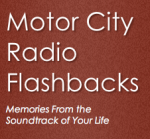 From the MCRFB news archive: 1966
From the MCRFB news archive: 1966
WKNR KEEPS SINGLES TITLE
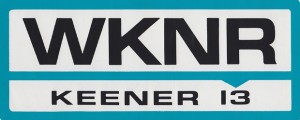 From the MCRFB Aircheck Library, featuring:
From the MCRFB Aircheck Library, featuring:
WKNR 1966: WKNR-AM – Bob Green – 1966
WKNR 1967: WKNR-AM – Scott Regen – 1967
WKNR 1967: WKNR-AM – Dick Purtan – 1967
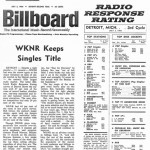
DETROIT — Despite a tight playlist — 31 records — WKNR has won the crown again as the major influence on sales on single records in the Detroit market — the nation’s fifth largest radio market. The latest Billboard Radio Response Rating survey shows the station with 47 per cent of the votes from record dealers, distributors, one-stop operators and local and national record executives. The next closet competitor has only 29 per cent of the votes.
WKNR had 44 percent of the votes in last year’s survey. Bob Green, the station’s major deejay, again took top honors as the major individual influence on the teen market with 30 percent of the votes.

Though WKNR plays comparatively few records over-all, the new records it exposes get extra emphasis, said program director Frank Maruca. Besides the 31 records on the playlist, Maruca features a key single and key album of the week and the top three selling albums, regardless of what they are. The key single and album, however, are brand new records Maruca feels will make the best seller charts.
Last week, the key single was “Friday’s Child” by Nancy Sinatra. Normally, the key single is by established artists, but “Day For Decision” by Johnny Sea was “out of left field. I even broke our rule and put it out (on the playlist) in the middle of the week and normally I would never do that except with the Beatles or the Supremes.”
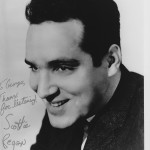
The key single of the week gets heavy airplay on the station. But, basically, Maruca believes that the tight playlist is the answer in today’s Hot 100 format radio. But, one thing for sure, the music is getting better,” he said. “The record buyers are becoming more selective and the music has to be much better than three or four years ago. When Frank Sinatra makes No. 1, like he is on our playlist now, that’s something to write home about. Too, the groups are turning out songs now with a melody. . . . the day of hard raucous songs are gone.” He said he thought teen-aimed music would continue to grow and improve.

WKNR set an all-time record in billings June 13, “and still have the rest of the month to go,” Maruca said. He attributed the popularity of the station in both audience and billings to personalities like Bob Green, who’s “an excellent straight personality with a quiet approach, Scott Regen, who’s become associated with top name artists, and Dick Purtan, who uses a lot of humor.” END
Addendum: Here’s the Radio Response Rating for WKNR in Detroit according to the Billboard Magazine July 2, 1966 edition:
* Top Stations (Pop Singles):
1. WKNR AM-FM 47% 2. CKLW AM – FM 29% 3. WXYZ AM – FM 24%
* Top Disk Jockeys (Pop Singles):
1. Bob Green, WKNR; 30% 2. Tom Shannon, CKLW; 20% 3. Scott Regen, WKNR; 15%
All Others: Lee Alan, WXYZ; Dave Prince, WXYZ; Joey Reynolds, WXYZ; Dave Shafer, CKLW; Duke Windsor, CKLW.
* Top Jockeys (Pop Singles) By Time Slot (Detroit Market):
Morning — Dick Purtan, WKNR; Mid-Morning — Ted Clark, WKNR; Early-Afternoon — Jerry Goodwin, WKNR; Traffic Man — Bob Green, WKNR; Early-Evening — Scott Regen, WKNR; Evening — J. Michael Wilson, WKNR; All Nite — Jim Jeffries, WKNR.
* Music Director, Program Director, Or Librarian (Most Influential In Exposing Records):
Paul Cannon, Assistant Program Director, WKNR; Hugh Frizzell, Program Director, CKLW; Dave Prince, Music Librarian, WXYZ.
MCRFB Note: Click all images for larger views.
(The WKNR Billboard July 2, 1966 page scan courtesy Scott Westerman’s Keener13.com; Bob Green, Scott Regen and Dick Purtan photos all courtesy the George Griggs Collection).
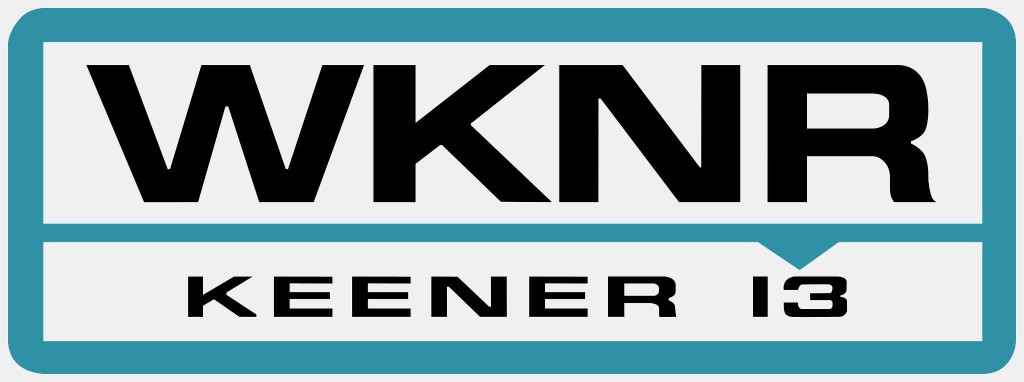
(Information and news source: Billboard; July 2, 1966)
![]()
 The BOB GREEN PRODUCTION STAFF is creative top market radio pro’s…. ready to service your station with ALL your production requirements, within AS SHORT A TIME AS TWO DAYS.
The BOB GREEN PRODUCTION STAFF is creative top market radio pro’s…. ready to service your station with ALL your production requirements, within AS SHORT A TIME AS TWO DAYS.
(Note: minus the Bob Green photo inserted, this advertisement source appeared in the ad section of Billboard Magazine; July 6, 1968).
![]()
From the MCRFB NEWS archive: 1965
RADIO RESPONSE ROUNDUP
WKNR, WJR Hitting Pay Dirt in Detroit, Thanks to Two Air Personalities
DETROIT — Two deejays — one in the Top 40 field and the other from a ‘middle-of-the-road’ easy music station, are basically responsible for the tremendous success of radio stations WKNR and WJR here in influencing the sales of records…. and may be largely responsible for the success of their respective radio stations in reaching a large audience.
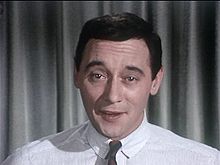
WJR station manager James H. Quello, said that his good music station was proud of J. P. McCarthy. “He’s the number one radio personality in town. Everybody knows him and he’s in good part responsible… a major factor… in influencing the sale of LP’s in Detroit.”
According to Billboard’s Radio Response Rating Survey last week of the Detroit radio market — ranked the country’s fifth radio market — McCarthy was rated No. 1 in influencing radio listeners to purchase popular LPs. The station was rated first in the same category, but what makes it a unique situation is that the station gained strength to capture the top position since a similar Billboard survey of May 16, 1964, had placed WJR in second-place behind WCAR.
And the reason, according to Quello, is the power of McCarthy. McCarthy had been with the station at one time, then left WJR in Detroit to work for another radio station in San Francisco. He returned back to Detroit since the last Billboard survey. He’s so effective that WJR placed him on mornings in their 6:30 a.m. to 9:00 a.m. time-frame, and he returns for the 3:15 p.m. to 6:00 p.m. drive time. “After all, this is the motor city of the world… a big car place,” Quello went on to say. McCarthy features mostly MOR records, Quello said, “but we’re programming more contemporary music now, anything short of rock and roll.”
In influencing the sale of popular LP recordings, the major stations, in order, are WJR, WCAR, WWJ, and WJBK. WJR and WCAR has most of the power; in fact, WJR’s McCarthy had 52 per cent of the total points in Billboard’s survey, followed by WCAR deejay Joe Bacarella with 36 per cent overall.
WJR, incidentally, tied for second-place with WWJ in influencing the sale of conservative type records, was No. 1 in influencing the sale of classical records, and showed up fairly well as a power in influencing the sale of folk records as well.
Both Gain
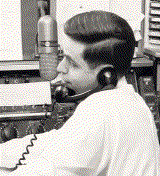
The top position in the sale of popular record singles was again captured by radio station WKNR and its popular disk-jockey, Bob Green. In fact, both station and deejay gained in strength. WKNR radio was rated at 33 per cent in May 16, 1964, but increased its influence to 44 per cent as of last week. Green increased two points to 30 per cent.
WKNR radio station manager Walter Patterson said the Top 40 station isn’t doing anything different, “but we are fortunate in accumulating listeners.” A recent Pulse study showed that the 24-hour Detroit station as reaching 292,900 separate households during a given day.
“We’re not cocky, but we watch our position closely and never let up,” Patterson said. While the station does believe in strong air-personalities, — “some are and some are not” — it also practices “playing more music and keeping talk to a minimum.” The station’s “sound” is very important,” Patterson said.
WKMH the former, now WKNR, featured a “middle-of-the-road” music format until November 1, 1963, when it went Top 40. “We’ve pulled the fastest turnaround of any station in the country,” Patterson said. “What’s happening is the more we go, the more we get.” The station plays the top 31 records and distributes 99,000 copies of the station’s own survey guide of featured songs and hits. Patterson also said the station has a “refrigerator full” of promotions and uses them as the need arises.
Also in the Top 40 market, radio station CKLW has increased its power in influencing the sales of records since the last Billboard survey. The market saw WJBK change format from Top 40, where it ranked No. 2 last May, to good music. In May 1964, it was No. 4; now it ranks second. Dave Shafer and Tom Shannon of CKLW now rank second and third behind WKNR’s Bob Green.
John Gordon, the program director of CKLW, received the Billboard nod as most co-operative in exposing new records.
Close in R&B Field
In the R&B field in the Detroit market, it was a close race, but WCHB radio came out on top in influencing record sales. WCHB had 49 per cent, WJLB had 44 per cent and FM station WGPR had 7 per cent. WJLB ranked first last May.
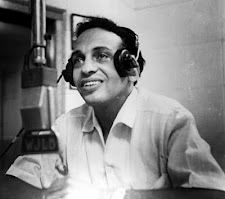
Bill Williams, program director at WCHB, attributed the station’s increase in influence to a “much tighter format that was launched in January.” The station also went 24-hours in April. Williams said deejays on WCHB are now faster with delivery than before. “We play 35 of the top-selling R&B records, interspersed with every third record with one we think is a good prospect for a potential hit-maker to climb-up the chart.” This has made the station very important in getting listeners to go out and buy more into the R&B product,” Williams said.
“This is a good R&B market, its the home of the Motown sound,” he said, adding that he liked to think of his market as the entire population of Detroit. WJLB, however, scored with the top disc-jockey — Ernie Durham — in the power of influencing record sales. In fact, Durham almost captured the whole thing with a 44 per cent influence in the Detroit R&B market. The second-place honors goes out to Le Baron Taylor of WCHB, who held the No. 2 spot at 27 per cent.
Interesting to note is that an FM station, WBRB-FM is now showing muscles in influencing the sales of country music records. The field is still dominated by country powerhouse WEXL, which still came up with 86 per cent of the total points, but it’s no longer a one-station field. WBRB showed up with a 14 per cent; it’s a new station since the last Billboard survey. Bill Samples, of WEXL, is still the No. 1 deejay in the motor town getting country music records sold. END
___
(Information and news source: Billboard; July 24, 1965)

![]()
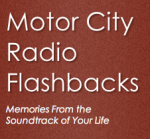 WKNR SIGNED OFF INTO HISTORY TODAY, APRIL 25, FORTY-YEARS AGO
WKNR SIGNED OFF INTO HISTORY TODAY, APRIL 25, FORTY-YEARS AGO

DETROIT (April 25, 2012) — WKNR-AM, once the dominate radio station in Detroit during the 1960s, signed-off the 1310 AM frequency for the last time on this day, April 25, 1972.

Formerly WKMH-AM, the station made the switch to “the new Radio 13” on October 31, 1963. By early 1964, WKNR was by then the most popular radio station in Detroit and remained No. 1 in the market, still holding that status throughout the first six months through 1967.
WKNR, affectionately known as “Keener 13,” began it’s eventual slide from Detroit radio dominance in April, 1967. It was during this time WKNR saw their challenge met head-on by their other rival located across the Detroit river, CKLW.
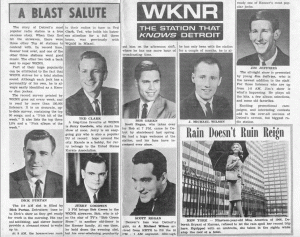
CKLW, during that time, was totally being restructured into a formidable radio powerhouse the Canadian station would become by year’s end.
RKO radio consultant Bill Drake and Paul Drew were the two people responsible for the major changes at the “Big 8.” Paul Drew, the newly-appointed program director at CKLW, patterned the same “Boss Radio” format Bill Drake and Ron Jacobs had programmed on 93 KHJ in Los Angeles. By 1965’s end, Jacob’s KHJ was by then the No. 1 radio station in L.A.
But WKNR would not easily go down without a fight. While going against the “Big 8” giant, the legendary Detroit radio station’s ratings were found inside a downward decline, all the while battling against two major fronts.
CKLW officially became the No. 1 radio station in Detroit by November, 1967, according to a Radio Response Survey published in Billboard on November 4.
CKLW, with it’s massive 50,000-watts of transmitted radio power covered 3 Canadian provinces and at times, their night-time signal spanned across 28 States. In contrast, after sundown, WKNR’s 5,000-watt signal was commonly known to be absent from the radio dial in areas east of Detroit and, more so, deficient in night-time coverage and strength.
By now, major changes had begun at WKNR both in the management and personnel level. In January of 1968, J. Michael Wilson was by then doing mornings on Keener. Dick Purtan had left WKNR for Baltimore. By the first week of April 1968, WKNR radio greats Bob Green, Jerry Goodwin, Ted Clark and Scott Regen were no longer there. Sean Conrad, Edward Alan Busch, Tony Randolph, Ron Sherwood, and Dan Henderson were to be the new voices on Keener 13.
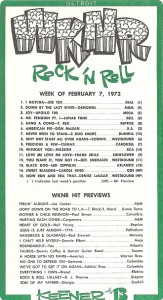
Despite the many changes in the Detroit radio market scene at the time, WKNR’s battle for survival against CKLW and FM’s “free-form” radio would drag on for five years.
Near the end of 1971, according to a Detroit Arbitron radio rating for the period Oct./Nov., WKNR-AM had a 6:00 a.m. to 12:00 a.m. cume of 377,300 in total listenership during a given broadcast day. For WKNR, those numbers represented a reduction down to a 15 to 12 total market share. In comparison, WABX-FM ranked just under in total rank, with a cume of 330,000 during those same hours.
WKNR, who by then revamped its playlist to include some album-oriented tracks, also made much of their attempt to pull away from the “same as” CKLW all-pop music format. No longer were the top 31 songs part of the playlist rotation. Slashed in half, WKNR’s new playlist focused primarily on the top 15 hits instead, while “previewing” the other 16 songs or so for the week.
By late 1971 and early 1972, WKNR now was promoting itself as the new “American Rock and Roll” radio station. An obvious affront towards the dominance that was CKLW located in Windsor, Ontario.
On the 100.3 FM side, the album rock-oriented ‘underground” format that was WKNR-FM was dropped after an unsuccessful run against WABX-FM. In it’s place, Stereo Island, an easy-listening music format, now found it’s place competing against WLDM-FM in Detroit.
But the changes were not enough, and ultimately, it was not to be.
In the end, WKNR became the former on a brisk, chilly but sunny morning that was Tuesday, April 25, 1972. Just before 8:00 a.m., WKNR deejay John McCrae’s voice breaks but regains composure as he announced the inevitable —
 (This original audio source is property, courtesy of Scott Westerman and keener13.com)
(This original audio source is property, courtesy of Scott Westerman and keener13.com)
“…This is John McCrae, I’d like to take it upon my, myself to speak on behalf of all the people who made Keener what it, was and is. You know, Pete Seeger, with a little help from his cosmic friend, wrote it much better than I could, and the Byrds sing it, much better than I, could ever say it. So this time Detroit, we’d like to thank you, for making nearly a decade — a Keener season.”
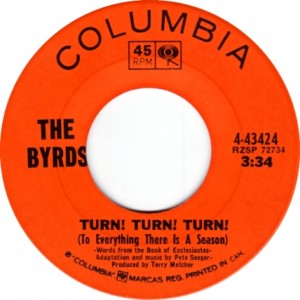
As the last few bars of the Byrd’s “Turn, Turn, Turn” began to fade, the magic that was once WKNR faded away with the song. But the memories, the events, the music, the great names, the faces and voices who crafted the Keener legacy a long time ago, remain in many a hearts and minds yet even still, to this day.
In 2002, thirty years since WKNR was last on the air, Scott Westerman and Steve Schram decided it was time someone gave WKNR it’s long due, with honors. Working together they packaged an incredibly amazing WKNR tribute site, aptly named, keener13.com.
This coming June, 2012, will mark a decade since the website’s creation. And the phenomenal story about this great Detroit radio legacy is still being told, remembered, and celebrated there on the world-wide web.
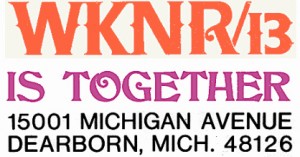
“Keener” was a radio station that went on to impact nearly a decade the many lives of a community it once served. It knew its listeners. And if only but for a short time, WKNR also was the station that, in all essence, knew the city of Detroit well by way of its prestigious award-winning news department informing and staying “on top of the news” during the station’s Top 40 reign here during the the 1960s and early-1970s.
As Bob Green previously commented to Scott Westerman on keener13.com, quote, “The WKNR experience provided some of my happiest radio memories.”
We agree.
As to a generation who grew up listening to top 40 radio in Detroit during the 1960s, one may actually say many of those “happiest radio memories” we recall having heard on Keener 13 — belongs to many of us today just the same.
WKNR. Those call letters would come to embody one sensational story. A story of a Detroit radio station’s historic top 40 run to number one status (in short-order all within 9 weeks) after having signed on in October 1963.
And it is a story still remembered to this day. Forty years after signing-off into Detroit radio history one April morning, on this day, in 1972.

A MCRFB NOTE: For a more comprehensive search in our MCRFB archives on WKNR to date, you may GO HERE.


![]()